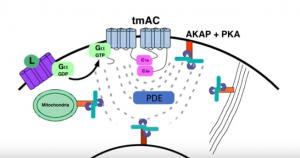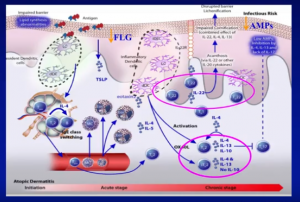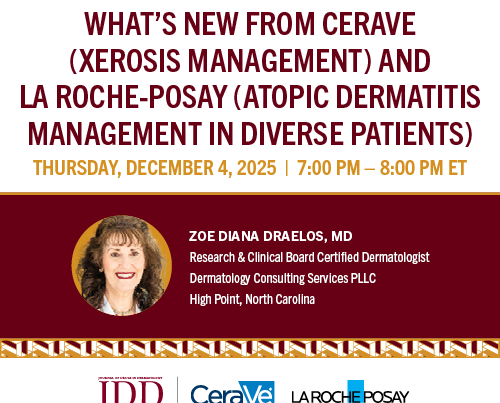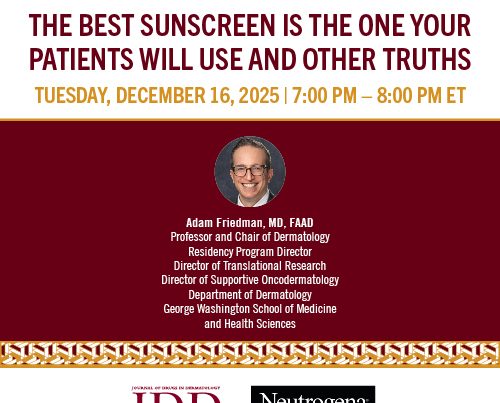Atopic Dermatitis Supplements
Masterful Topical JAK Inhibitor
Janus kinase (JAK) inhibitors, which have been used in a range of disease states from rheumatology to gastroenterology, have been finally adopted into dermatology. These agents are rapidly changing the ways that dermatologists treat a range of inflammatory skin diseases, particularly atopic dermatitis (AD).
Real-World Patient Cases Using Botanical Serum-Containing Corrective Gel as an Adjunct to Aesthetic Facial Energy-Based Device Treatments
Integrated skin care is defined as the complementary use of topical treatments to nonsurgical facial rejuvenation procedures, such as lasers and radiofrequency microneedling devices, to produce pleasing aesthetic results. Real-world experience from expert dermatologists is invaluable in guiding patient treatment plans, as there are limited clinical trials on the efficacy of integrated skincare regimens. The SkinCeuticals (New York, NY) Phyto Corrective gel (botanical serum-containing corrective gel) contains a lightweight botanical serum that hydrates, calms, and soothes skin. It contains antioxidant and anti-inflammatory ingredients derived from plant
and fruit extracts, making it an appealing option for adjunctive treatment of post-procedure erythema and swelling.
Prebiotic Skincare Management of Atopic Dermatitis & Xerosis in Diverse Ethnically Patients
Atopic Dermatitis (AD) is a chronic relapsing inflammatory skin disease associated with a significant patient burden on quality-of-life. Rising evidence demonstrate skin microbiome playing an essential role in AD pathogenesis. A decrease in skin microbial diversity, particularly an overabundance of Staphylococcus aureus colonization, is observed on AD lesional skin, plus is associated with disease severity.
Management of Atopic Dermatitis
The treatment horizon for pediatric AD is encouraging. Newer pharmaceuticals are now joined by novel formulations of established medications, which arms dermatologists with an increasing array of treatments to tackle this challenging condition.
The Biological Impact of Oats: Eczema and Beyond
Blair Allais MD, Adam Friedman MD
The objective of this Supplement is to highlight the data supporting the use of colloidal oatmeal in the treatment of atopic dermatitis and other skin conditions resulting from an impaired skin barrier or inflammation. Clinical efficacy and tolerance will be highlighted.
While colloidal oatmeal is the only ingredient in the skin protectant FDA monograph indicated for atopic dermatitis, there are still gaps in knowledge among professionals on the mechanisms of action that make this ingredient efficacious for conditions with impaired barrier function and inflammation. Upon completion of this Supplement, readers should understand the mechanisms of action of all components of oats that contribute to demonstrated efficacy in atopic dermatitis as well as other skin conditions and populations that have impaired barrier function and chronic itch associated with eczema/dry skin. [FREE TEXT]
Colloidal Oatmeal Part I: History, Basic Science, Mechanism of Action, and Clinical Efficacy in the Treatment of Atopic Dermatitis
Blair Allais MD, Adam Friedman MD FAAD
In Part 1 of this two-part series, we will explore the history of colloidal oatmeal, basic science, mechanism of action, and clinical efficacy in the treatment of atopic dermatitis. Colloidal oatmeal has a long-standing history in the treatment of dermatologic disease. It is composed of various phytochemicals, which contribute to its wide-ranging function and clinical use. It has various mechanisms of action including direct anti-inflammatory, anti-pruritic, anti-oxidant, anti-fungal, pre-biotic, barrier repair properties, and beneficial effects on skin pH. These have been shown to be of particular benefit in the treatment of atopic dermatitis. [FREE TEXT]
Colloidal Oatmeal Part II: Atopic Dermatitis in Special Populations and Clinical Efficacy and Tolerance Beyond Eczema
Blair Allais MD, Adam Friedman MD FAAD
In Part II of this 2-part series, we examine the efficacy, safety, and expansive clinical applications of colloidal oatmeal. Colloidal oatmeal has a diverse array of applications, clinical benefits, and uses beyond atopic dermatitis. First and foremost, it has been shown to be of benefit in the treatment of atopic dermatitis in skin of color. It has also been shown to be of benefit in the treatment of hand dermatitis, xerosis, psoriasis, skin manifestations of diabetes, and in the treatment of cutaneous adverse effects associated with oncologic therapies. [FREE TEXT]
Management of Atopic Dermatitis
Leon H. Kircik MD
The treatment horizon for pediatric AD is encouraging. Newer pharmaceuticals are now joined by novel formulations of established medications, which arms dermatologists with an increasing array of treatments to tackle this challenging condition. [FREE TEXT]
Prebiotic Skincare Management of Atopic Dermatitis & Xerosis in Diverse Ethnically Patients
Atopic Dermatitis (AD) is a chronic relapsing inflammatory skin disease associated with a significant patient burden on quality-of-life. Rising evidence demonstrate skin microbiome playing an essential role in AD pathogenesis. A decrease in skin microbial diversity, particularly an overabundance of Staphylococcus aureus colonization, is observed on AD lesional skin, plus is associated with disease severity.
The Biological Impact of Oats: Eczema and Beyond
Blair Allais MD, Adam Friedman MD
The objective of this Supplement is to highlight the data supporting the use of colloidal oatmeal in the treatment of atopic dermatitis and other skin conditions resulting from an impaired skin barrier or inflammation. Clinical efficacy and tolerance will be highlighted.
While colloidal oatmeal is the only ingredient in the skin protectant FDA monograph indicated for atopic dermatitis, there are still gaps in knowledge among professionals on the mechanisms of action that make this ingredient efficacious for conditions with impaired barrier function and inflammation. Upon completion of this Supplement, readers should understand the mechanisms of action of all components of oats that contribute to demonstrated efficacy in atopic dermatitis as well as other skin conditions and populations that have impaired barrier function and chronic itch associated with eczema/dry skin. [FREE TEXT]
Colloidal Oatmeal Part I: History, Basic Science, Mechanism of Action, and Clinical Efficacy in the Treatment of Atopic Dermatitis
Blair Allais MD, Adam Friedman MD FAAD
In Part 1 of this two-part series, we will explore the history of colloidal oatmeal, basic science, mechanism of action, and clinical efficacy in the treatment of atopic dermatitis. Colloidal oatmeal has a long-standing history in the treatment of dermatologic disease. It is composed of various phytochemicals, which contribute to its wide-ranging function and clinical use. It has various mechanisms of action including direct anti-inflammatory, anti-pruritic, anti-oxidant, anti-fungal, pre-biotic, barrier repair properties, and beneficial effects on skin pH. These have been shown to be of particular benefit in the treatment of atopic dermatitis. [FREE TEXT]
Colloidal Oatmeal Part II: Atopic Dermatitis in Special Populations and Clinical Efficacy and Tolerance Beyond Eczema
Blair Allais MD, Adam Friedman MD FAAD
In Part II of this 2-part series, we examine the efficacy, safety, and expansive clinical applications of colloidal oatmeal. Colloidal oatmeal has a diverse array of applications, clinical benefits, and uses beyond atopic dermatitis. First and foremost, it has been shown to be of benefit in the treatment of atopic dermatitis in skin of color. It has also been shown to be of benefit in the treatment of hand dermatitis, xerosis, psoriasis, skin manifestations of diabetes, and in the treatment of cutaneous adverse effects associated with oncologic therapies. [FREE TEXT]
Management of Atopic Dermatitis
Leon H. Kircik MD
The treatment horizon for pediatric AD is encouraging. Newer pharmaceuticals are now joined by novel formulations of established medications, which arms dermatologists with an increasing array of treatments to tackle this challenging condition. [FREE TEXT]
Sponsored
Podcast Episodes
Choosing Wisely: Capitalizing on Atopic Dermatitis Clinical Trial Data for Meaningful Selection of Topical Agents
We are finally getting what we asked for: Pharma is ponying up for head to head studies to provide us with meaningful data to help make better clinical decisions. However, these valuable projects are often with systemic agents, such as biologics, leaving topical treatments in the dust. To address this, Dr. Lawrence Eichenfield, Professor of Dermatology and Pediatrics, UCSD, and colleagues sought to make the most out of the data we do have on the litany of topical options for atopic dermatitis and provide efficacy and safety guidance (A for effort!). Tune in to hear what this dream team concocted about creams. Hear how an expert approaches new atopic dermatitis patients. Don’t miss out – this is all very topical.
Trending Now: Shifts and Gaps in Atopic Dermatitis Management by Derm and Non-Derm Physicians
Back by popular demand, Dr. Steven Feldman, Professor of Dermatology, Pathology and Public Health joins host Dr. Adam Friedman from GW School of Medicine to review his recent database dive entitled “Trends in Atopic Dermatitis Management: Comparison of 1990-1997 to 2003-2012.” What new trends, both good and bad, have emerged? What can we expect and hope for the future of AD care? What tricks of the trade do these two employ when utilizing systemic immunosuppressants? Itching for answers? Make sure to tune in…
Go superpotent or go home: The utility and safety of Class 1 topical steroids
In this edition of the JDD Podcast, Ask the Investigator, host Dr. Adam Friedman digs deep with UCSF Assistant Professor of Dermatology Dr. Tina Bhutani to powerlift the most up to date safety data on Class 1 superpotent topical steroids from her study entitled “Update on the Systemic Risks of Superpotent Topical Steroids.” Is steroid phobia valid, or does proper use of steroids properly protect from the adverse event boogeyman. Hear from the expert how to effectively use topical steroids while limiting local and systemic side effects, and how to get your patients on board, especially those nay sayers. Do not miss this clinically relevant and im-POTENT podcast ( nailed it!).
We’re Not Alone: The role of the cutaneous microbiota in maintaining skin health
In this special edition of the JDD podcast, with consideration from La Roche-Posay, host Dr. Adam Friedman is joined by Acne guru Dr. Hilary Baldwin, Director of the Acne Research Center and Associate Professor of Dermatology at SUNY Downstate, to review the cutting edge of cutaneous microbiome research and translational applications. Yes you are covered in bacteria – accept it, own it, and love it. Learn how harmony between the >500 species on our skin keep our barrier and cutaneous immunity in check, and conversely, how dysbiosis can facilitate a broad range of cutaneous pathology. This special edition is not to be missed!
CME Library
Choosing Wisely: Capitalizing on Atopic Dermatitis Clinical Trial Data for Meaningful Selection of Topical Agents
Sponsored
Translational Lecture Series
Targeting cAMP Signaling for the Treatment of Inflammatory Diseases of the Skin
 Dr. Jon Zippin, Assistant Attending Dermatologist and Assistant Professor of Dermatology at Weill Medical College of Cornell, elucidates the complexity of cAMP biology and the translational impact of PDE4 inhibition as it relates to chronic inflammatory skin diseases. Tune in to learn why targeting this pathway is clinically meaningful but also where more work is needed to improve outcomes.
Dr. Jon Zippin, Assistant Attending Dermatologist and Assistant Professor of Dermatology at Weill Medical College of Cornell, elucidates the complexity of cAMP biology and the translational impact of PDE4 inhibition as it relates to chronic inflammatory skin diseases. Tune in to learn why targeting this pathway is clinically meaningful but also where more work is needed to improve outcomes.
Update on Pediatric Inflammatory Skin Disorders: How Pathogenesis Informs Treatment
 Dr. Amy Paller, Walter J. Hamlin Professor and Chair of Dermatology & Professor of Pediatrics at Northwestern University Feinberg School of Medicine in Chicago, Illinois, delivers a presentation discussing the cause and treatment of pediatric Atopic Dematitis, including co-morbidities, epidermal barrier impairment, and compliance issues.
Dr. Amy Paller, Walter J. Hamlin Professor and Chair of Dermatology & Professor of Pediatrics at Northwestern University Feinberg School of Medicine in Chicago, Illinois, delivers a presentation discussing the cause and treatment of pediatric Atopic Dematitis, including co-morbidities, epidermal barrier impairment, and compliance issues.
Itch form Bedside to Bench
 Dr. Gil Yosipovitch, Professor of Dermatology at University of Miami Miller School of Medicine, provides residents and physicians access to the latest bench research and practical pearls from a master in pruritus that will help them offer the highest quality evidence-based dermatological care.
Dr. Gil Yosipovitch, Professor of Dermatology at University of Miami Miller School of Medicine, provides residents and physicians access to the latest bench research and practical pearls from a master in pruritus that will help them offer the highest quality evidence-based dermatological care.
JDD Blog

What’s New from CeraVe (Xerosis Management) and La Roche-Posay (Atopic Dermatitis Management in Diverse Patients)









